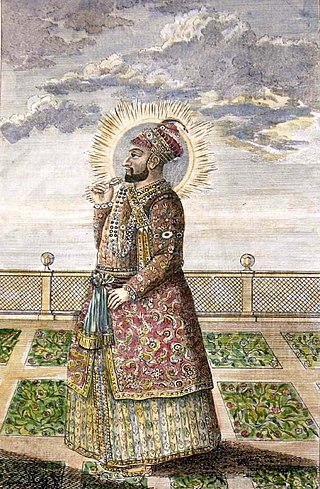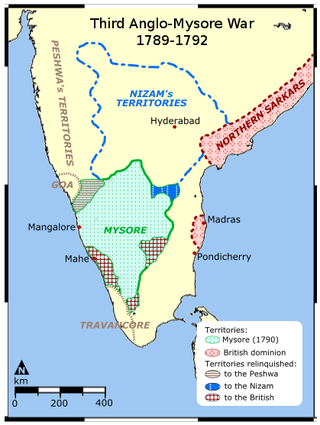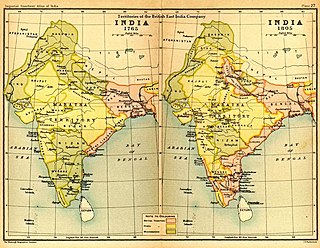
Tipu Sultan, commonly referred to as Sher-e-Mysore or "Tiger of Mysore", was the Indian Muslim ruler of the Kingdom of Mysore based in South India. He was a pioneer of rocket artillery. He introduced a number of administrative innovations during his rule, including a new coinage system and calendar, and a new land revenue system, which initiated the growth of the Mysore silk industry. Tipu was also a pioneer in introducing Channapatna toys. He expanded the iron-cased Mysorean rockets and commissioned the military manual Fathul Mujahidin. He deployed the rockets against advances of British forces and their allies during the Anglo-Mysore Wars, including the Battle of Pollilur and Siege of Srirangapatna.

Hyder Ali was the Sultan and de facto ruler of the Kingdom of Mysore in southern India. Born as Hyder Ali, he distinguished himself as a soldier, eventually drawing the attention of Mysore's rulers. Rising to the post of Dalavayi (commander-in-chief) to Krishnaraja Wodeyar II, he came to dominate the titular monarch and the Mysore government. He became the de facto ruler of Mysore as Sarvadhikari by 1761. During intermittent conflicts against the East India Company during the First and Second Anglo–Mysore Wars, Hyder Ali was the military leader.

The Maratha Empire was an early modern Indian empire and later a confederation that controlled large portions of the India in the 18th century. Maratha rule formally began in 1674 with the coronation of Shivaji of the Bhonsle dynasty as the Chhatrapati. Although Shivaji came from the Maratha caste, the Maratha empire also included warriors, administrators, and other nobles from the Maratha and several other castes from what is known today as Maharashtra. The Maratha Kingdom was expanded into a full-fledged Empire in the 18th Century under the leadership of Peshwa Bajirao I.

The First Anglo-Mysore War (1767–1769) was a conflict in India between the Sultanate of Mysore and the East India Company. The war was instigated in part by the machinations of Asaf Jah II, the Nizam of Hyderabad, who sought to divert the company's resources from attempts to gain control over the Northern Circars.

The Anglo-Mysore Wars were a series of four wars fought during the last three decades of the 18th century between the Sultanate of Mysore on the one hand, and the British East India Company, Maratha Empire, Kingdom of Travancore, and the Kingdom of Hyderabad on the other. Hyder Ali and his succeeding son Tipu fought the wars on four fronts: with the British attacking from the west, south and east and the Nizam's forces attacking from the north. The fourth war resulted in the overthrow of the house of Hyder Ali and Tipu, and the dismantlement of Mysore to the benefit of the East India Company, which took control of much of the Indian subcontinent.

The Third Anglo-Mysore War (1790–1792) was a conflict in South India between the Kingdom of Mysore and the British East India Company, the Kingdom of Travancore, the Maratha Confederacy, and the Nizam of Hyderabad. It was the third of four Anglo-Mysore Wars.

The Fourth Anglo-Mysore War was a conflict in South India between the Kingdom of Mysore against the British East India Company and the Hyderabad Deccan in 1798–99.

The Maratha Conquests were a series of conquests in the Indian subcontinent which led to the building of the Maratha Empire. These conquests were started by Shivaji in 1659, from the victory at the Battle of Pratapgad against Bijapur. The expansion of the empire was limited and interrupted by the Mughal conquests of south India by Mughal ruler Aurangzeb until he eventually died in 1707 in Deccan itself. Marathas were forced to defend their territories against the overwhelmingly strong Mughal army in the 27 years long Deccan wars. They were able to defend their territories and gain an upper hand over Mughals in the sustained conflict.

Madhavrao II was the 12th Peshwa of the Maratha Empire in India, from his infancy. He was known as Sawai Madhav Rao or Madhav Rao Narayan. He was the posthumous son of Narayanrao Peshwa, murdered in 1773 on the orders of Raghunathrao. Madhavrao II was considered the legal heir, and was installed as Peshwa by the Treaty of Salbai in 1782 after First Anglo-Maratha War.

The battle honour of Mysore commemorates the action of native units of the British East India Company in the Third Anglo-Mysore War of 1789–92.

Dhondia Wagh was a military soldier and adventurer in 18th century India. He started his career in the service of Hyder Ali, the ruler of Mysore. During the Third Anglo-Mysore War, he deserted Ali's successor Tipu Sultan, and subsequently raided territories on the Maratha-Mysore border. After the Marathas forced him to retreat, he sought refuge from Tipu and converted to Islam, changing his name to Malik Jahan Khan. After Tipu's death in the Fourth Anglo-Mysore War, he raised a force comprising soldiers from the former Mysore Army, and took control of northern part of the Mysore Kingdom. He styled himself as Ubhaya-Lokadheeshwara. The British East India Company as well as the Maratha Peshwa sent armies to check his rising power. He was ultimately defeated and killed by a British force led by Arthur Wellesley.

The Battle of Nedumkotta took place between December 1789 and May 1790, and was a reason for the opening of hostilities in the Third Anglo-Mysore War. This battle was fought between Tipu Sultan of the Kingdom of Mysore and Dharma Raja, Maharaja of Travancore. Mysore army attacked the fortified line in Thrissur district at the Travancore border known as the Nedumkotta. The Mysore army was successfully repulsed by the Travancore army under the leadership of Raja Kesavadas, Dewan of Travancore.

The 1792 siege of Seringapatam was a battle and siege of the Mysorean capital city of Seringapatam (Srirangapatna) at the end of the Third Anglo-Mysore War. An army led by Charles, Earl Cornwallis, consisting of British East India Company and British Army forces, along with allied forces from the Maratha Empire and the Nizam of Hyderabad, arrived at Seringapatam on 5 February 1792, and after less than three weeks of battle and siege, forced Tipu Sultan to capitulate. With his agreement to the Treaty of Seringapatam on 18 March 1792, the war came to an end.

British General Charles Cornwallis, the Earl Cornwallis, was appointed in February 1786 to serve as both Commander-in-Chief of British India and Governor of the Presidency of Fort William, also known as the Bengal Presidency. He oversaw the consolidation of British control over much of peninsular India, setting the stage for the British Raj. He was also instrumental in enacting administrative and legal reforms that fundamentally altered civil administration and land management practices there. According to historian Jerry Dupont, Cornwallis was responsible for "laying the foundation for British rule throughout India and setting standards for the services, courts, and revenue collection that remained remarkably unaltered almost to the end of the British era."
The 'Maratha–Mysore wars were a conflict in the 18th century India between the Maratha Confederacy and the Kingdom of Mysore. Though initial hostilities between the sides started in 1770s, the last battle began in February 1785 and ended in 1787.
The siege of Bahadur Benda occurred when the forces of Mysore led by Tipu Sultan besieged Bahadur fort in 1787. Tipu Sultan defeated the Maratha Army led by Hari Pant and captured the fort. It was the last military engagement between the Maratha Empire and Tipu Sultan.

The siege of Adoni was a military conflict that occurred between the forces of Tipu Sultan of the Kingdom of Mysore and the Maratha Empire allied with the Nizam of Hyderabad in 1756.

Sham Raj I ; born as Renuka Das Bhalerao,; popularly known as Raja Sham Raj Rai Rayan, was a general, a statesman, and an Indian noble who served as Prime Minister of Hyderabad. He is also known as Raja Shan Rai Rayan Renuka Das.
The Battle of Savanur occurred between the Kingdom of Mysore and Maratha Empire. The Mysore forces led by Tipu Sultan defeated the Maratha at Savanur in October 1786. The Maratha Army led by Hari Pant retreated, and the Mysore army entered Savanur.
The Capture of Kanchangarh was a military expedition led by Tipu Sultan against the Marathas who had captured the town. This took place in 1786. The Maratha armies were led by Hari Pant Phirkia. This expedition was aimed at expelling the Marathas from the territory of the Mysore Sultanate.














